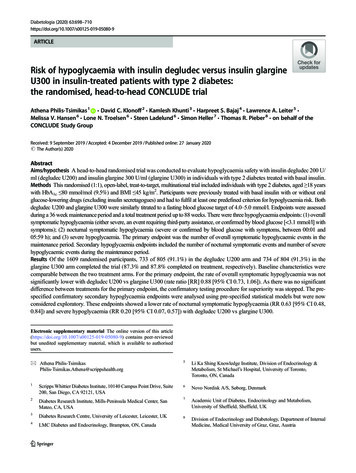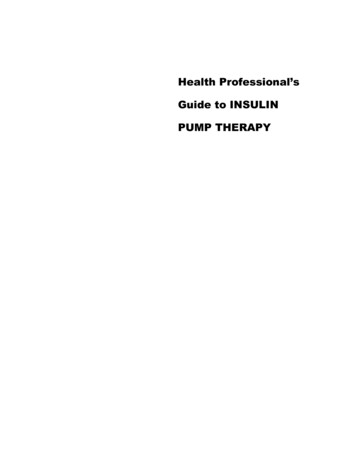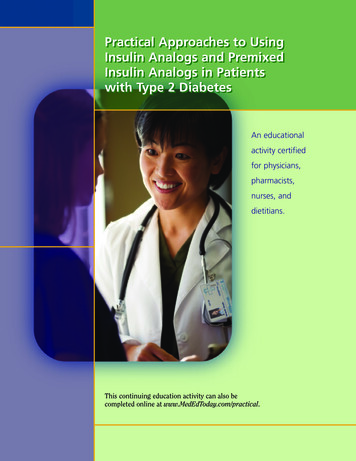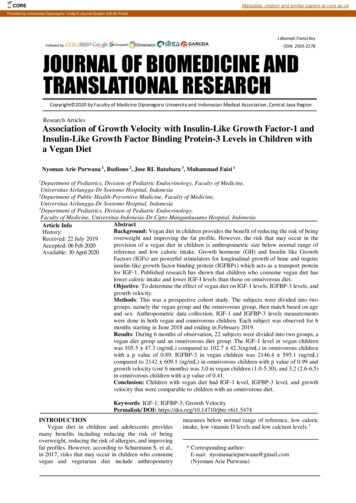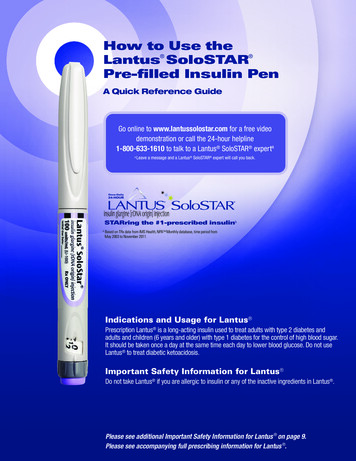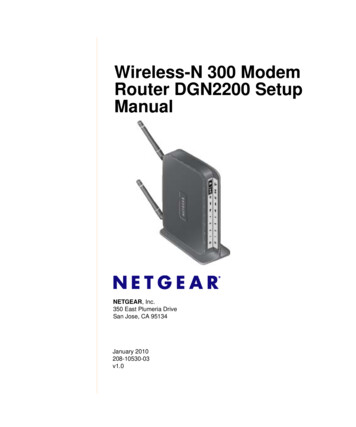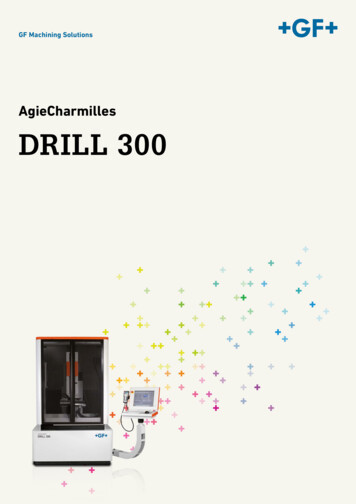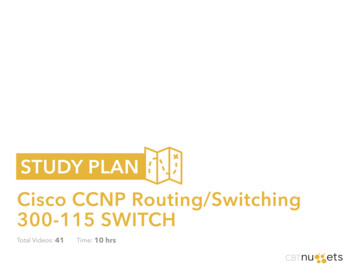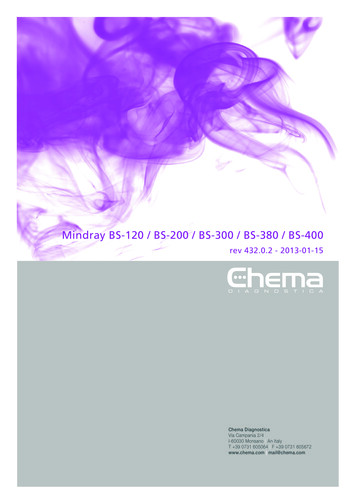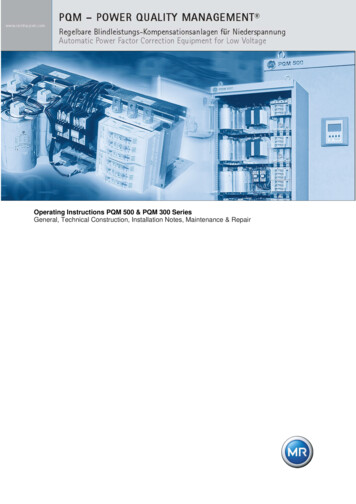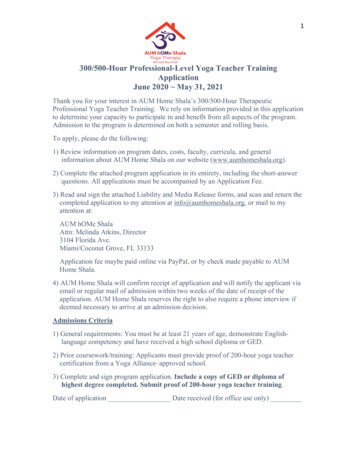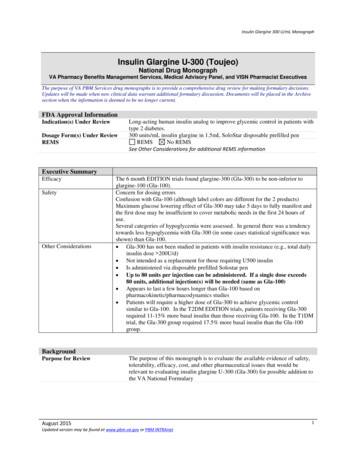
Transcription
Insulin Glargine 300 U/mL MonographInsulin Glargine U-300 (Toujeo)National Drug MonographVA Pharmacy Benefits Management Services, Medical Advisory Panel, and VISN Pharmacist ExecutivesThe purpose of VA PBM Services drug monographs is to provide a comprehensive drug review for making formulary decisions.Updates will be made when new clinical data warrant additional formulary discussion. Documents will be placed in the Archivesection when the information is deemed to be no longer current.FDA Approval InformationIndication(s) Under ReviewDosage Form(s) Under ReviewREMSLong-acting human insulin analog to improve glycemic control in patients withtype 2 diabetes.300 units/mL insulin glargine in 1.5mL SoloStar disposable prefilled penREMSNo REMSSee Other Considerations for additional REMS informationExecutive SummaryEfficacySafetyOther ConsiderationsThe 6 month EDITION trials found glargine-300 (Gla-300) to be non-inferior toglargine-100 (Gla-100).Concern for dosing errorsConfusion with Gla-100 (although label colors are different for the 2 products)Maximum glucose lowering effect of Gla-300 may take 5 days to fully manifest andthe first dose may be insufficient to cover metabolic needs in the first 24 hours ofuse.Several categories of hypoglycemia were assessed. In general there was a tendencytowards less hypoglycemia with Gla-300 (in some cases statistical significance wasshown) than Gla-100. Gla-300 has not been studied in patients with insulin resistance (e.g., total dailyinsulin dose 200U/d) Not intended as a replacement for those requiring U500 insulin Is administered via disposable prefilled Solostar pen Up to 80 units per injection can be administered. If a single dose exceeds80 units, additional injection(s) will be needed (same as Gla-100) Appears to last a few hours longer than Gla-100 based onpharmacokinetic/pharmacodynamics studies Patients will require a higher dose of Gla-300 to achieve glycemic controlsimilar to Gla-100. In the T2DM EDITION trials, patients receiving Gla-300required 11-15% more basal insulin than those receiving Gla-100. In the T1DMtrial, the Gla-300 group required 17.5% more basal insulin than the Gla-100group.BackgroundPurpose for ReviewThe purpose of this monograph is to evaluate the available evidence of safety,tolerability, efficacy, cost, and other pharmaceutical issues that would berelevant to evaluating insulin glargine U-300 (Gla-300) for possible addition tothe VA National FormularyAugust 2015Updated version may be found at www.pbm.va.gov or PBM INTRAnet1
Insulin Glargine 300 U/mL MonographOther Therapeutic OptionsFormulary AlternativesInsulin glargine 100 units/mL*Insulin detemir*NPH insulin*VISNs can choose either as apreferred agentNon-formulary AlternativesU-500Other ConsiderationsSignificantly lower cost than Gla-300Other ConsiderationsDoes not have a dedicated syringe or pen device; TBsyringe (recommended by ISMP) or U-100 syringe isusedExtensive patient training needed on how to properlydraw up dosePotential for syringe-related dosing errorsRequires 2 or more injections per dayCan be used in an insulin pumpU-500 behaves like basal and prandial insulin, so it isthe sole source of exogenous insulin for the patientEfficacy (FDA Approved Indications)Literature Search SummaryA literature search was performed on PubMed/Medline (1966 to July 16, 2015) using the search term insulinglargine 300. The search was limited to studies performed in humans and published in the English language.Review of EfficacyThe FDA approval of Gla-300 was based on the phase 3a EDITION program which includes 3 randomized, openlabel trials in patients with T2DM and 1 trial in those with T1DM. Trials were 6 months in duration 6 monthextensions (2 trials have 12-month data published). Of the T2DM trials, 2 were add-on to oral agents and the otherwas add-on to mealtime insulin metformin (Table 1). There are also 2 smaller trials (JP-1 and JP-2) conducted inJapanese patients (Table 2).The primary outcome was change in A1C from baseline. The trials were designed to show non-inferiority versusGla-100. If non-inferiority criteria were met, testing for superiority was conducted.General inclusion criteria: EDITION 1: T2DM, age 18 years, A1C 7.0-10%, use of Gla-100 or NPH 42 units/day mealtime insulinanalog metformin for 1 year EDITION 2: T2DM, age 18 years, A1C 7.0-10% , use of Gla-100 or NPH 42 units/day OADs for 1 year EDITION 3: T2DM, age 18 years, A1C 7.0-11%, used oral glucose medications for 6months; insulin naïve EDITION 4: T1DM 1 year, age 18 years, use of any mealtime insulin analog 3 months, A1C 7-10%Baseline characteristics of patients in EDITION 1-3 were mean A1C 8.3%, age 59 years, 53% male, weight 100kg,2BMI 35 kg/m , duration of diabetes 13 years, 81% used metformin, 22% sulfonylureas, and DPP-4 inhibitors 10%.Baseline characteristics of patients in EDITION 4 were A1C 8.1%, age 47.3 years, 57% male, weight 81.8kg, BMI27.6 kg/m2, duration of diabetes 21 years, 73.4% used glargine, 14% detemir, 2.7% NPH, 13% on twice daily basalinsulin.Dosing of study drugIn EDITIONS 1 and 2, patients previously receiving once daily glargine or NPH started the same dose used prior torandomization. Those receiving prior twice daily NPH had their study drug dose reduced by approximately 20%.The same held for EDITION 4 except that patients previously receiving detemir could be enrolled; dosing of studydrug was handled same as those on prior NPH.In EDITIONS 1-3, study drug was administered in the evening (from before the evening meal until bedtime) at thesame time each day for each individual patient. In EDITION 4, the injection was administered either in the morningbetween pre-breakfast and pre-lunch or evening (same as in EDITION 1-3).August 2015Updated version may be found at www.pbm.va.gov or PBM INTRAnet2
Insulin Glargine 300 U/mL MonographStudy drug was adjusted once weekly to a pre-breakfast SMBG goal of 80-100mg/dl based on the median of theprevious 3 days. Adjustments for both groups were restricted to changes divisible by 3 units, the smallestadjustment possible for Gla-300 due to the characteristics of the pen injector. Split dosing of study drug was givenfor those requiring 80 U of Gla-100 or 180U of Gla-300 (EDITION 1) and 80 U of Gla-100 or 90U of Gla-300(EDITION 3).Mealtime insulin was administered in EDITION 1 and 4. Mealtime insulin doses were adjusted at the discretion ofthe investigator after optimizing the basal dose (EDITION 1). In EDITION 4, the prestudy dose was used andtitrated to a 2-h postprandial SMBG goal of 160mg/dL while avoiding hypoglycemia.Oral antiglycemic medication use was as follows: In EDITION 1, metformin was continued at prestudy dose. InEDITION 2, OADs were continued at prestudy dose; prior SUs were discontinued. In EDITION 3, OADs werecontinued prestudy dose; prior SUs, meglitinides, and agents not approved for combination with insulin werediscontinued.Rescue treatment was allowed in EDITION 2 and 3 at the investigators discretion.Glycemic EfficacyEDITION 1-4 Trials (Table 1): In the 6-month EDITION trials, Gla-300 was found to be noninferior to Gla-100in reducing A1C. However, the 12-month data for EDITION 1 showed significantly greater reduction in A1C withGla-300 than Gla-100 (0.86% vs. 0.69. Patients will require a higher dose of Gla-300 to achieve glycemic controlsimilar to Gla-100. In the T2DM EDITION trials, patients receiving Gla-300 required 11-15% more basal insulinthan those receiving Gla-100. In the T1DM trial, the Gla-300 group required 17.5% more basal insulin than the Gla100 group. The dose of rapid acting insulin was similar between the 2 groups. Change in fasting glucose wassimilar between Gla-300 and Gla-100.Japanese Trials (Table 2): In JP-1, patients with T1DM were randomized to Gla-300 or Gla-100 in addition torapid acting insulin. In JP-2, patients with T2DM were randomized to Gla-300 or Gla-100 in addition to their usualoral agents. There was no significant difference in change in A1C between the 2 treatment groups.Treatment SatisfactionThere was no difference in treatment satisfaction between Gla-300 and Gla-100.August 2015Updated version may be found at www.pbm.va.gov or PBM INTRAnet3
Insulin Glargine 300 U/mL MonographTable 1: Selected Outcomes in the EDITION Trials (Glycemic Improvement, Insulin Dose, Weight)nDM therapy at screeningBaseline A1C (%)Δ A1C (%)EDITION 1 (Type 2)6-month dataGla-300 Gla-100 RAIRAI MET MET404403Basal mealtime insulin MET8.158.16A1C 7% (%)Baseline FPG (mg/dL)Δ FPG (mg/dL)EDITION 1 (Type 2)12-month dataGla-300 Gla-100 RAIRAI MET MET404402Basal mealtime insulin MET8.158.16EDITION 2 (Type 2)6-month dataGla-300 Gla-100 OHAOHA403405Basal insulin TION 2 (Type 2)12-month dataGla-300 Gla-100 OHAOHA403405Basal insulin OHAs8.38.3Mean tx diff-0.06% [95% CI -0.22, 0.10]NSNS148142Mean tx diff0.18mg/dL [-0.22, 0.57]8.210.1EDITION 3 (Type 2)6-month dataGla-300 Gla-100 OHAOHA432430Insulin naïve OHAs8.58.6EDITION 4 (Type 1)6-month dataGla-300 Gla-100 RAIRAI274275Basal mealtime 818615199-61.4-68.4-17-20Rescue (%)NANANANA5.74.93.02.0NABasal dose U/kg/d (U/d)Baseline0.67 (70)0.67 (70.3)0.66(64.1)0.68 (65.7)NANA0.38Final0.97 (103)0.88 (94)1.03 (NS)0.90 (NS)0.92 (91)0.84 (82)0.970.870.62 (59.4)0.53 (52)0.47Mealtime dose .550.550.560.33Baseline weight .9Δ Weight viations: FPG fasting plasma glucose; Gla glargine; MET metformin; NA not applicable; NS not shown; OHA oral hypoglycemic agent; RAI rapid-acting insulin analog; sx symptomatic; TDI total dailyinsulin*Significant vs. Gla-100Table 2: A1C, Weight, and Insulin Dose in the JP TrialsJP-1 (Type 1)nBaseline A1C (%)Δ A1C (%)A1C 7% (%)Final total insulin dose (U/kg/day)Weight (kg)Gla-300 RAI1218.1-0.3015.60.79-0.1August 2015Updated version may be found at www.pbm.va.gov or PBM INTRAnetGla-100 RAI1228.1-0.43200.740.4JP-2 (Type 2)Gla-300 OHAGla-100 A0.370.400.33NS81.81.06
Insulin Glargine 300 U/mL MonographTable 3: Hypoglycemia (EDITION 1-4)EDITION 1 (Type 2)6-month dataGla-300 Gla-100 RAIRAI MET MET404403EDITION 1 (Type 2)12-month dataGla-300 Gla-100 RAIRAI MET MET404402EDITION 2 (Type 2)6-month dataGla-300 Gla-100 OHAOHA403405EDITION 2 (Type 2)12-month dataGla-300 Gla-100 OHAOHA403405nHypoglycemia % (E/pt-yr)Any83.4 (26.37)88.6 (28.08)NSNS71.5* (14.37) 79.3 (18.96)79.9 (11.87)83.0 (13.70)Documented sx 7070 (13.48)77.9 (14.76)74.8* (12.07) 82.8 (11.7)49.6* (6.76)57.4 (8.11)58.8 (5.71)63.3 (5.74)Documented sx 5437.4 (2.43)41.5 (2.65)46 (2.19)50.7 (2.08)20.6 (1.11)26.8 (1.46)27.5 (0.92)29.8 (0.94)Severe5.0 (0.27)5.7 (0.24)6.7 (0.19)7.5 (0.14)1.0 (0.03)1.5 (0.06)1.7 (0.03)1.5 (0.03)Asymptomatic 7063.1 (11.39)68.2 (11.24)70.5 (9.75)73.4 (8.79)NSNSNSNSConfirmed 70 or severe81.9 (25.48)87.8 (26.76)85.9* (22.34) 91.5 (20.99)70* (14.01)77.3 (18.14)78.4 (11.60)82.0 (13.18)Nocturnal Hypoglycemia% (E/pt-yr)Any45.3 (3.32)59.7 (4.57)NSNS30.5* (1.98)41.6 (3.95)39.7 (1.80*)46.1 (2.94)Documented sx 7035.9 (1.92)48.3 (3.22)44.6* (1.83*) 57.2 (2.49)22.6* (1.25)31.0 (2.30)29.5 (1.17)34.2 (1.60)Documented sx 5412.1 (0.46)16.9 (0.64)19.8 (0.47)22.9 (0.51)8.2 (0.27)11.6 (0.57)12.7 (0.27)13.3 (0.37)Severe2.0 (0.06)2.5 (0.08)2.5 (0.04)3.2 (0.05)0 (0)0.5 (0.01)0.2 (0.00)0.5 (0.01)Asymptomatic 7020.8 (1.10)25.4 (0.88)29.2 (0.97)31.1 (0.63)NSNSNSNSConfirmed 70 or severe44.6 (3.13)57.5 (4.20)54.5* (2.88)64.7 (3.19)28.3* (1.89)39.9 (3.68)37.5* (1.74*) 44.6 (2.77)Abbreviations: Gla glargine; MET metformin; NS not shown; OHA oral hypoglycemic agent; RAI rapid-acting insulin analog; sx symptomatic*Significant vs. Gla-100Definitions of hypoglycemia:Any hypoglycemia: events whether confirmed by SMBG or not and whether symptomatic or asymptomaticDocumented symptomatic symptomatic event with SMBG 70 or 54mg/dLSevere events requiring assistance by another person to administer carbohydrate, glucagon, or other therapyAsymptomatic asymptomatic event with SMBG 70mg/dLConfirmed or severe documented symptomatic or asymptomatic events severe eventsAugust 2015Updated version may be found at www.pbm.va.gov or PBM INTRAnet5EDITION 3 (Type 2)6-month dataGla-300 Gla-100 OHAOHA432430EDITION 4 (Type 1)6-month dataGla-300 Gla-100 RAIRAI274275NS30.6 (2.33*)7.6* (0.24)0.9 (0.02)NS46.2 (6.41*)NS35.8 (3.76)13.9 (0.45)0.9 (0.02)NS52.5 (8.50)NS85 (NS)69 (NS)6.6 (NS)NS93.1(78.4)NS83.6 (NS)69.8 (NS)9.5 (NS)NS93.5 ( 72.5)NS12.4 (0.76)3.2 (0.10)0 (0)NS17.9* (1.31)NS15.5 (0.84)6.4 (0.18)0 (0)NS23.5 (1.34)NS59.1 (NS)40.9 (NS)2.2 (NS)NS68.6 (8.0)NS57.8 (NS)38.9 (NS)2.5 (NS)NS70.2 (8.9)
Insulin Glargine 300 U/mL MonographPotential Off-Label UseNoneSafety(for more detailed information refer to the product package insert)Boxed tsNone During episodes of hypoglycemia Hypersensitivity to insulin glargine or its excipientsNever share glargine 300 Solostar pen between patients even if the needle is changedHypoglycemia or hypoglycemia with changes in insulin regimen: The onset of action of Gla-300develops over 6 hours. The full glucose lowering effect may not be seen for at least 5 days.Patients who were changed to Gla-300 from other basal insulins had a higher average fasting plasmaglucose levels in the first weeks of therapy compared to those who were switched toGla-100.Higher doses of Gla-300 were needed to achieve similar levels of glucose control compared to Gla100Medication Errors: Potential for mix-up between different types of insulin. Instruct patients toalways check the insulin label before each injectionSafetyConsiderationsAs with other insulin products, there is a risk for hypersensitivity and allergic reactions,hypokalemia, and fluid retention/heart failure with concomitant use of thiazolidinediones.HypoglycemiaOverall and nocturnal hypoglycemia as percentage of patients experiencing 1 event andannualized rates was assessed according to several predefined categories (Table 3). In general therewas a tendency towards less hypoglycemia with Gla-300, with some cases being statisticallysignificant, than Gla-100. It has been speculated that the smoother pharmacokinetic andpharmacodynamics profile of Gla-300 may explain the lower risk of hypoglycemia.A main secondary endpoint for EDITIONS 1-3 was the percentage of patients with one or moreconfirmed ( 70mg/dL) nocturnal or severe nocturnal hypoglycemic events from week 9 to month 6(Table 4). In EDITION 1 and 2, Gla-300 resulted in significantly fewer episodes compared to Gla100; the difference in EDITION 3 was not significant.Table 4: Confirmed ( 70mg/dL) Nocturnal or Severe NocturnalHypoglycemic Events (week 9 to month 6)EDITION 1EDITION 2EDITION 3Gla-30036.1 (2.97)21.6 (1.94)16 (NS)%(E/pt-yr)Gla-10045.8 (4.05)27.9 (3.19)17 (NS)%(E/pt-yr)RR [95%CI]0.790.770.89Based on % pts[0.67, 0.93]*[0.61, 0.99]*[0.66, 1.20]*significant vs. Gla-100% percentage of patients experiencing 1 event; NS not shown; RR relative riskCardiovascular SafetyNo trials have been conducted with Gla-300. A cardiovascular outcomes trial (ORIGIN) has beenconducted with Gla-100 compared to standard of care evaluating time to first occurrence of a majoradverse cardiovascular event (MACE). MACE was defined as the composite of CV death, nonfatalMI, and nonfatal stroke. The incidence of MACE was similar between Gla-100 and standard of careHR 1.02 [95%CI 0.94, 1.11]. It is unknown whether the results from this trial can be applied toAugust 2015Updated version may be found at www.pbm.va.gov or PBM INTRAnet6
Insulin Glargine 300 U/mL MonographGla-300.MalignancyThere were concerns that Gla-100 might predispose to cancer. The ORIGINS trial showed that thehazards ratio of cancer and death from cancer were 0.99[95%CI 0.88, 1.11] and 0.94 [95%CI 0.77,1.15] respectively. It is unknown whether the results from this trial can be applied to Gla-300.Injection site reactionsIn EDITION 1-3, injection site reactions were reported in 2.4% and 3.1% of patients receiving Gla300 and Gla-100 respectively. However, 12-month data from EDITION 1 reported injection sitereactions in 3% of Gla-300 and 1.5% of Gla-100 patients whereas the 12 month data from EDITION2, the incidence was 1.2% and 3.0% respectively. In EDITION 4, injection site reactions werereported in 2.2% and 1.5% patients respectively.ImmunogenicityAnti-insulin antibodies were similar between Gla-300 and Gla-100 across the EDITION 1-4 trials.WeightMean weight change in a pooled analysis of the 3 T2DM trials was 0.51kg and 0.79kg for Gla-300and Gla-100 respectively. Treatment difference -0.28 [95%CI -0.55, -0.01], p 0.039. The 12month data for EDITION 1-2 continued to show less weight gain with Gla-300 (statisticallysignificant in EDITION 2). In EDITION 4, there was significantly less weight gain with Gla-300than Gla-100 (0.51kg and 1.06kg respectively). Table 1The JP trials showed a slight decrease in mean weight with Gla-300 and a slight increase in weightwith Gla-100 (Table 2).Adverse ReactionsCommon adversereactionsCommon AEs, defined as reactions occurring in 5% of the population werenasopharyngitis and upper respiratory tract infection.Table 5: Adverse Events Occurring in 5% of the PopulationNasopharyngitisUpper Respiratory Tract InfectionDeath/Serious adversereactions (SAE)T2DM (n 1,242)7.15.7T1DM (n 304)12.89.5None of the deaths were considered to be related to study drug. There was no discussionon whether any of the SAEs were thought to be related to study drug.Table 6: Deaths and Serious Adverse EventsEDITION 1EDITION 1EDITION 2EDITION 26 month12 month12 monthDeaths *Gla-3001224(n)Gla-1002402Gla-3006.4133.77.4SAE (%)Gla-1005.2153.77.4*In EDITION 1, 3 additional deaths occurred after treatment discontinuationDiscontinuations dueto adverse reactionsEDITION 3EDITION 4106.06.0106.28.0EDITION 3EDITION 41.01.01.11.1Table 7: Discontinuations from Study due to Adverse EventsD/C dueto AE (%)Gla-300Gla-100EDITION 16 month1.51.7August 2015Updated version may be found at www.pbm.va.gov or PBM INTRAnetEDITION 112 month2.23.5EDITION 21.51.0EDITION 112 month2.71.77
Insulin Glargine 300 U/mL MonographDrug InteractionsDrug-drug interactionsDrug-food interactionsDrug-lab interactionsSame as those reported for the insulin classNoneNoneRisk EvaluationAs of May 2015Sentinel event advisoriesLook-alike/sound-alike errorpotentials! The Institute for Safe Medication Practices (ISMP) includes this medication among its listof drugs which have a heightened risk of causing significant patient harm when used inerror. Due to the number of insulin preparations, it is essential to identify/clarify the typeof insulin to be used.Sources: ISMP, FDA, TJCSources: Based on clinical judgment and an evaluation of LASA information fromthree data sources (Lexi-Comp, First Databank, and ISMP Confused Drug NameList)NME DrugNameLexi-CompFirst DataBankISMPClinicalJudgmentInsulin glargine300 units/mLInsulin glulisineNoneNoneInsulin glargine100 units/mLInsulin aspart(VA LASA list)Toujeo SolostarNoneNoneNoneTyvasoForteoOther ConsiderationsStorageUnopened pens should be stored in a refrigerator (36-46 F). Open (in-use) pens should be kept at roomtemperature away from direct heat and light. The pen must be discarded 28 days after being opened.Pharmacokinetics/PharmacodynamicsIn a randomized, double-blind, crossover study, the pharmacokinetics and pharmoacodynamics of Gla-300 and Gla100 were compared in patients with T1DM (n 18) using euglycemic clamp method. Patients received 0.4 units/kgof either drug for 8 days and were crossed-over to the other drug for an additional 8 days. Assessments were madeunder steady state conditions. Ther
Gla-300 than Gla-100 (0.86% vs. 0.69. Patients will require a higher dose of Gla-300 to achieve glycemic control similar to Gla-100. In the T2DM EDITION trials, patients receiving Gla-300 required 11-15% more basal insulin than those receiving Gla-100. In the T1DM trial, the Gla-300 group
